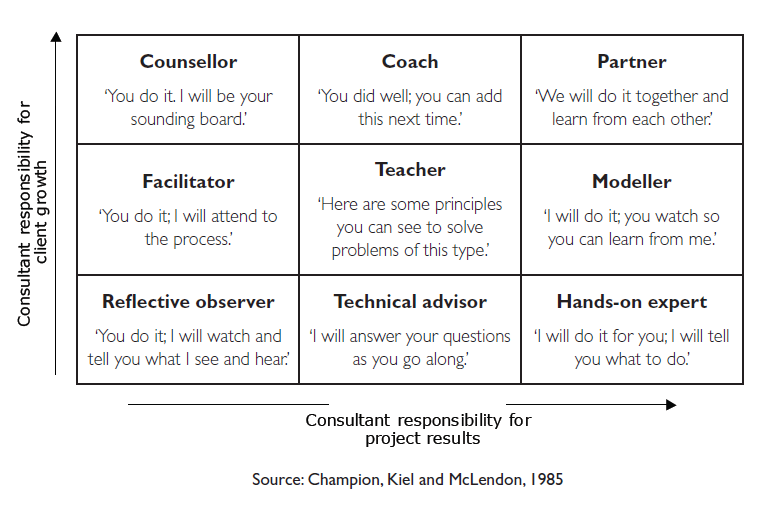« Champion Kiel et al 2010 » : différence entre les versions
(Page créée avec « Catégorie:chapitre <!-- Catégorie regroupant les chapitres d'ouvrages collectifs. Idéalement, encoder d'abord l'ouvrage général avant d'encoder un chapitre particul... ») |
|||
| (2 versions intermédiaires par le même utilisateur non affichées) | |||
| Ligne 45 : | Ligne 45 : | ||
<!-- Copier / coller ici l'abstract --> | <!-- Copier / coller ici l'abstract --> | ||
Both external advisers and internal change agents can choose very different roles in capacity-development processes. Over the duration of an assignment or project, a competent adviser takes on a variety of positions in relation to different people or parts of the client system. This demands a critical awareness of types of roles and judgements about what is needed when. In their article originally published in Training and Development journal February 1990, Champion, Kiel and McLendon identify nine possible roles and suggest key factors to consider in making judgements about which consulting role to take on. Their model helps advisers, change agents or consultants to improve the clarity of expectations between themselves and their clients. The article also explores factors that consultants may consider when adjusting their role towards a particular situation or phase of a project. Though it was written 20 years ago and not specifically targeted at the development community, this text is still highly relevant and addresses questions that will be very familiar to practitioners. | |||
<br> | |||
== 5. Résumé personnel (facultatif) == | == 5. Résumé personnel (facultatif) == | ||
<!-- Entrer ici un résumé personnel de la ressource(facultatif) --> | <!-- Entrer ici un résumé personnel de la ressource(facultatif) --> | ||
Intéressant pour le schéma ci-dessous qui définit 9 rôles d'accompagnant selon 2 axes : implication dans le produit/résultat et dans le développement de la personne. Applicable au CP. | |||
[[Fichier:9roles.png]] | |||
A noter qu'une traduction française du schéma est proposée par [[Massé 1998]]. | |||
Dernière version du 22 décembre 2015 à 06:17
Choosing a Consulting Role: Principles and Dynamics of Matching Role to Situation
1. Références
- Référence complète APA : Champion, D. P., Kiel, D. H., & McLendon, J. A. (2010). Choosing a Consulting Role: Principles and Dynamics of Matching Role to Situation. In J. Ubels, N.-A. Acquaye-Baddoo & A. Fowler (dir.), Capacity development in practice. London & Washington, DC : Earthscan.
- Auteur(s) : [[]]
- Livre : [[]]
2. Copies
- Copie en ligne : http://www.snvworld.org/fr/publications/capacity-development-in-practice-chapter-4-advisers-roles-choosing-a-consulting-role
- Copie locale : Fichier:Champion Kiel et al 2010.pdf
- Copie physique : voir l'ouvrage.
3. Mots-clés
4. Résumé officiel / abstract
Both external advisers and internal change agents can choose very different roles in capacity-development processes. Over the duration of an assignment or project, a competent adviser takes on a variety of positions in relation to different people or parts of the client system. This demands a critical awareness of types of roles and judgements about what is needed when. In their article originally published in Training and Development journal February 1990, Champion, Kiel and McLendon identify nine possible roles and suggest key factors to consider in making judgements about which consulting role to take on. Their model helps advisers, change agents or consultants to improve the clarity of expectations between themselves and their clients. The article also explores factors that consultants may consider when adjusting their role towards a particular situation or phase of a project. Though it was written 20 years ago and not specifically targeted at the development community, this text is still highly relevant and addresses questions that will be very familiar to practitioners.
5. Résumé personnel (facultatif)
Intéressant pour le schéma ci-dessous qui définit 9 rôles d'accompagnant selon 2 axes : implication dans le produit/résultat et dans le développement de la personne. Applicable au CP.
A noter qu'une traduction française du schéma est proposée par Massé 1998.
